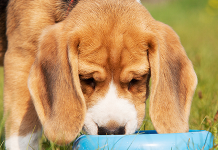When is a Pekingese Full Grown?
A Pekingese is considered full grown when it reaches its adult size, which is usually around one year of age. However, some Pekingese may continue to develop and fill out until they are around 18 months old. Like many small dog breeds, Pekingeses reach their full physical maturity relatively early compared to larger breeds, which may take up to two years or more to reach full growth.

It’s important to note that while their size may have reached its maximum, Pekingese, like all dogs, can continue to learn and develop mentally throughout their lives with proper training and socialization. Additionally, the rate of growth and development can vary from one individual Pekingese to another.
What Impacts the Size of a Pekingese?
The size of a Pekingese can be influenced by several factors, including:
Genetics: The most significant factor that determines the size of a Pekingese is its genetic makeup. The size of the parents and their ancestors plays a crucial role in determining the size of the offspring. If both parents are smaller in size, the puppies are more likely to be smaller as well.
Breed Standards: Each dog breed has specific breed standards set by kennel clubs and breed organizations. These standards outline the ideal size and physical characteristics of the breed. Responsible breeders strive to produce Pekingeses that conform to these standards, including size.
Nutrition: Proper nutrition during the puppy’s growth phase is essential for reaching its full potential size. A well-balanced diet with the right nutrients and appropriate portion sizes can contribute to healthy growth.
Health: A Pekingese that experiences health issues during its growth phase may not reach its full size. Conditions like malnutrition, developmental disorders, or chronic illnesses can impede proper growth and development.
Neutering/Spaying: Studies have shown that early neutering or spaying can affect a dog’s growth and size. Generally, dogs neutered or spayed before reaching sexual maturity may have slightly altered growth patterns compared to intact dogs.
Exercise: Regular exercise is vital for a Pekingese’s overall health, but excessive exercise during the puppy’s growth phase can potentially impact bone development. It is essential to strike a balance between exercise and rest to ensure healthy growth.
Environmental Factors: Environmental factors can also have a subtle influence on a Pekingese’s size. Factors such as living conditions, stress levels, and overall well-being can play a role in their growth and development.
Remember, every Pekingese is unique, and while these factors can influence their size, there can be variations among individual dogs of the same breed. Proper care, attention to nutrition, and regular veterinary check-ups are crucial for ensuring a Pekingese reaches its full potential size in a healthy and happy manner.
How Big Do Pekingeses Get?
The size of Pekingeses can vary, but on average, they typically stand about 6 to 9 inches (15 to 23 cm) tall at the shoulder. Their weight can range from approximately 7 to 14 pounds (3 to 6 kg). These measurements are based on the American Kennel Club (AKC) breed standards.
It’s important to note that some Pekingeses may be slightly smaller or larger than the average range due to individual variations and genetic factors. Additionally, the size of a Pekingese can be influenced by factors such as genetics, nutrition, and overall health.
Pekingeses are considered a small toy breed, and their compact size makes them ideal companions for living in apartments or smaller living spaces. Despite their small stature, they are known for their courageous and affectionate personalities, making them wonderful and loyal companions.
When Do Pekingeses Stop Growing?
Pekingeses typically stop growing in height and length by around one year of age. However, their growth plates, which are areas of developing cartilage at the ends of bones, may continue to close and harden until they are around 18 months old. This process finalizes their skeletal growth.
It’s essential to remember that while their height and length may have reached their maximum, Pekingeses may continue to gain weight and fill out in terms of muscle mass and body composition until they are around 18 months old. During this time, they are transitioning from puppyhood to adulthood.
It’s essential to provide proper nutrition, exercise, and regular veterinary check-ups during this growth phase to ensure that the Pekingese develops into a healthy and well-proportioned adult dog. Additionally, their behavior and energy levels may continue to evolve as they mature into adult dogs.
When Do Pekingeses Calm Down?
Pekingeses, like most dog breeds, will experience a decrease in their puppy energy levels as they mature into adulthood. Generally, Pekingeses begin to calm down between the ages of 1 to 2 years old. By this time, they have reached their physical and mental maturity, and their behavior tends to stabilize.
The puppy phase is often characterized by high energy, curiosity, and a playful demeanor. As they grow older, they will start to mellow out and become more settled. However, it’s important to note that individual Pekingeses may have varying personalities and energy levels, so some may calm down earlier or later than others.
To help your Pekingese transition into a well-behaved and calm adult dog, consistent training, socialization, and regular exercise are essential during their early years. These practices can help them develop good manners, reduce anxiety, and channel their energy in a positive way.
Remember that even as they calm down, Pekingeses will still benefit from mental stimulation and regular exercise to keep them happy and healthy throughout their lives. Proper care and attention will ensure a long-lasting and loving relationship with your furry companion.
Do Males and Females Grow the Same Size?
In general, male and female Pekingeses tend to be similar in size, but there can be slight differences. In many dog breeds, males are often slightly larger and heavier than females, but this is not always the case with Pekingeses. The size difference between male and female Pekingeses is usually minimal and not significant.
Both male and female Pekingeses typically fall within the same height and weight ranges, with the average height being about 6 to 9 inches (15 to 23 cm) at the shoulder and an average weight of 7 to 14 pounds (3 to 6 kg). However, as with any breed, there can be individual variations, and some females might be larger or smaller than some males.
It’s important to note that size is just one aspect of a dog’s characteristics, and temperament, personality, and behavior are not determined by their gender. Each Pekingese will have its unique personality regardless of whether it is male or female.
If you are considering getting a Pekingese, focus on finding a reputable breeder and selecting a puppy based on its temperament and compatibility with your lifestyle rather than worrying about gender-specific size differences. With proper care, training, and socialization, both male and female Pekingeses can make wonderful and loving companions.
How To Measure the size of a Pekingese?
Measuring the size of a Pekingese involves determining both their height and weight. Here’s how you can do it:
Height Measurement:
- Stand your Pekingese on a flat, level surface, such as the floor or a sturdy table.
- Position your Pekingese to stand up straight with all four legs firmly on the ground.
- Use a tape measure or a ruler to measure the height from the ground to the highest point of their shoulders (the withers). This is the height at the shoulder.
Weight Measurement:
- Use a pet scale or a regular scale that allows you to weigh small animals.
- If using a regular scale, step on the scale while holding your Pekingese, and then weigh yourself without the dog. The difference between the two weights is your Pekingese’s weight.
It’s essential to keep in mind that Pekingeses are small and sensitive dogs, so handling them gently and ensuring their comfort during the measuring process is crucial. If your Pekingese is uncooperative or anxious, you might need someone to assist you in holding them still during the measurements.
Additionally, regular weighing and monitoring of your Pekingese’s weight are essential to ensure they maintain a healthy weight throughout their life. Proper nutrition and regular exercise are vital components of keeping your Pekingese in good shape and maintaining their overall health and well-being. If you have any concerns about your Pekingese’s size or health, consult with a veterinarian for guidance and advice.
Pekingese Life Expectancy
The life expectancy of a Pekingese typically ranges from 12 to 15 years, although some Pekingeses can live even longer with proper care and a healthy lifestyle. Like all breeds, individual factors such as genetics, diet, exercise, and overall healthcare play a significant role in determining how long a Pekingese will live.
To help ensure a longer and healthier life for your Pekingese, consider the following tips:
Regular Veterinary Check-ups: Schedule regular visits to the veterinarian for check-ups, vaccinations, and preventive care.
Balanced Diet: Provide a well-balanced and nutritious diet that is appropriate for your Pekingese’s age, size, and activity level.
Exercise: Regular exercise is essential to keep your Pekingese physically and mentally stimulated. However, be mindful not to overexert them, especially during hot weather.
Dental Care: Dental hygiene is crucial for your Pekingese’s overall health. Brush their teeth regularly and consider dental cleanings when necessary.
Grooming: Regular grooming is necessary to keep your Pekingese’s coat clean and free from mats. It also allows for early detection of any skin or coat issues.
Socialization and Training: Proper socialization and training can help reduce stress and anxiety in your Pekingese, contributing to a happier and healthier life.
Safety: Provide a safe and secure environment for your Pekingese, both indoors and outdoors, to prevent accidents and injuries.
By providing love, care, and attention to your Pekingese throughout its life, you can help maximize their life expectancy and create a strong bond with your beloved furry companion.
Fun Facts About Pekingeses
Sure, here are some fun facts about Pekingeses:
Ancient Breed: Pekingeses are one of the oldest dog breeds, with a history dating back over 2,000 years. They were originally bred as companions for Chinese royalty and nobility.
Lion-Like Appearance: Pekingeses are often referred to as “lion dogs” because their long, flowing mane and mane-like coat resemble the appearance of a lion.
Regal Demeanor: Due to their history as royal companions, Pekingeses are known for their regal and dignified demeanor. They often carry themselves with a sense of self-importance.
Brachycephalic Breeds: Pekingeses have a short, flat face, which makes them part of the brachycephalic breed group. This facial structure can sometimes lead to breathing difficulties and heat sensitivity.
Unique Coat Colors: Pekingeses come in a variety of coat colors, including gold, red, black, black and tan, and sable. They often have a distinctive black mask on their face.
Independent Thinkers: Despite their small size, Pekingeses are known for their independence and can be a bit stubborn during training. Patience and positive reinforcement are essential when teaching them commands.
Affectionate Companions: Once they form a bond with their owners, Pekingeses are incredibly loyal and affectionate. They thrive on attention and enjoy spending time with their family.
Sensitive to Extreme Temperatures: Due to their brachycephalic features, Pekingeses can be sensitive to extreme temperatures. They should be kept in a comfortable environment, especially during hot weather.
Tendency to Bark: Pekingeses are alert and will often bark to alert their owners of any potential intruders or unusual sounds.
Low Exercise Needs: While they enjoy short walks and playtime, Pekingeses are generally not a high-energy breed. They are well-suited for apartment living and don’t require excessive exercise.
Social with Other Pets: With proper socialization, Pekingeses can get along well with other pets and children, making them a great addition to families.
These charming and distinctive traits make Pekingeses a beloved and cherished breed among dog lovers worldwide.
Pekingese Full Grown: Frequently Asked Questions
When is a Pekingese considered full grown?
A Pekingese is typically considered full grown when it reaches its adult size, which is usually around one year of age. However, some Pekingese may continue to develop and fill out until they are around 18 months old.
What impacts the size of a Pekingese?
The size of a Pekingese can be influenced by factors such as genetics, nutrition, health, exercise, and environmental factors.
How big do Pekingeses get?
Pekingeses are a small toy breed, and they typically stand about 6 to 9 inches (15 to 23 cm) tall at the shoulder and weigh around 7 to 14 pounds (3 to 6 kg).
When do Pekingeses stop growing?
Pekingeses usually stop growing in height and length by around one year of age, but their growth plates may continue to close and harden until they are around 18 months old.
When do Pekingeses calm down?
Pekingeses start to calm down between the ages of 1 to 2 years old, as they mature into adulthood. However, individual variations in behavior and energy levels can occur.
Do males and females grow the same size?
In general, male and female Pekingeses are similar in size, but there may be slight differences. Males may be slightly larger and heavier, but the size difference is typically minimal.
How to measure the size of a Pekingese?
To measure the size of a Pekingese, measure their height at the shoulder from the ground and weigh them using a pet scale or a regular scale with the assistance of subtraction.
What is the life expectancy of a Pekingese?
The life expectancy of a Pekingese is typically between 12 to 15 years, depending on various factors such as genetics, diet, exercise, and overall healthcare.
What are some fun facts about Pekingeses?
Pekingeses are one of the oldest dog breeds, known for their lion-like appearance, regal demeanor, and unique coat colors. They are also independent thinkers and can be sensitive to extreme temperatures.
Conclusion
In conclusion, Pekingeses are charming and ancient dog breeds known for their lion-like appearance, regal demeanor, and affectionate companionship. They typically reach their full size around one year of age, and their growth plates may continue to close until around 18 months old. While Pekingeses can be independent thinkers and may take time to calm down, they are loyal and loving companions once they form a strong bond with their owners.
The size of a Pekingese is influenced by genetics, nutrition, health, and environmental factors, and they are generally a small toy breed, standing about 6 to 9 inches tall and weighing 7 to 14 pounds. Their life expectancy is around 12 to 15 years, and providing proper care, nutrition, and regular veterinary check-ups can contribute to their longevity and overall well-being.
Pekingeses are fascinating dogs with a rich history, making them beloved pets for families and individuals alike. Their unique characteristics, such as their distinctive coat colors and sensitivity to extreme temperatures, make them stand out among other dog breeds. With patience, love, and attention, Pekingeses can be wonderful and loyal companions, bringing joy to their owners’ lives for many years to come.






